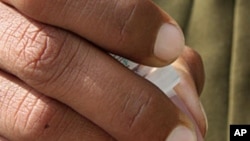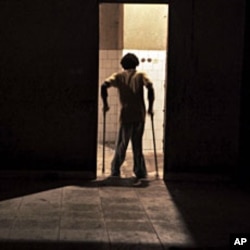India recently celebrated a year of being polio-free. This is a remarkable achievement in a country that until recently was recognized as the world’s epicenter of polio. India’s momentous accomplishment is boosting prospects of polio becoming only the second disease after smallpox to have been eradicated. To ensure that it remains polio-free, India is holding a second round of National Immunization Days. Between February 19 and 25, vaccinators aim to immunize 172 million children against polio.
Staff Benda Bilili, a group of eight former street musicians from Kinshasa, Congo, are singing their signature song "Polio." Four of the musicians are disabled polio victims. They sing about the disease that drastically changed their lives. They urge parents to immunize their children. They travel throughout Africa on a mission to kick polio out of the continent.
Sona Bari is external relations officer for the World Health Organization’s Global Polio Eradication Initiative. She said, "A year has passed in which no child in India has been paralyzed by polio for the first time in history."
She says India has always been considered the toughest place on earth to stop the virus. But she notes it has achieved this milestone through political will, huge funding by Rotary International, and determination and persistence by the whole society.
"India and Indians had to be committed for a decade to month after month of vaccination activities," said Bari. "House to house to vaccinate children, keeping surveillance for polio very high and finding the most remote and inaccessible populations to ensure that every last child was reached."
Now that India has stopped the transmission of the wild poliovirus, only three polio endemic countries remain - Nigeria, Pakistan and Afghanistan.
Bruce Aylward is WHO assistant director for polio, emergencies and country collaboration. He said the "main challenge and problems are definitely right now going to be in northern Nigeria and Pakistan."
"Basically, the whole 20-year, 10-plus-billion-dollar effort now hinges on how well some district or local government area leaders are in vaccinating their kids, and probably what would amount to somewhere around 40 or 50 districts in the entire world. It really is now coming down to that with the progress recently made in India," said Aylward.
In 2003, religious and political leaders in Kano, Nigeria, claimed the polio vaccine was part of a Western conspiracy to sterilize girls. Immunizations stopped. As a consequence, hundreds of Nigerian children became disabled and the virus spread to neighboring countries.
Bruce Aylward says both governments and health providers have learned from this experience. All are more vigilant, and great pains are being taken to make sure communities understand the importance of immunizing their children against this dreadful disease.
"It is a horrific, painful, devastating disease for the child, often for the family and then often even for the communities…Once polio is eliminated, we will also eliminate an incredible barrier to development, an incredible barrier to productivity for not just countries, but obviously the communities that are affected by polio and the children that are affected by polio," Aylward said.
When WHO launched its Global Polio Eradication Initiative in 1988, 350,000 children were paralyzed or killed by this crippling disease every year. That number fell to 647 cases in 17 countries last year. WHO estimates about $10 billion has been spent on polio eradication so far. The United Nations agency says the world stands to benefit by $40 billion to $50 billion in net health savings 20 years after transmission is stopped.
For United Nations Children's Fund Senior Health Specialist Brigitte Toure, the question is not one of if the job can get done, but when. "The big achievement of India in one year is to have demonstrated that it is possible to stop polio," she said. "You know that in the world, 99 percent of the countries have stopped polio…We are confident that we will stop this polio outbreak, but we have to work."
India’s achievement is converting skeptics into believers. The results are there for all to see. India shows polio can be eradicated if the political commitment and the money are there to bring this dreaded disease to an end.
Campaign supporters argue that too much has been invested in the polio eradication initiative to abandon it. They warn the consequences of failure are too terrible to contemplate. They say the world, once again, would be faced with hundreds of thousands of children becoming paralyzed or dying from this horrific, but preventable, disease.















